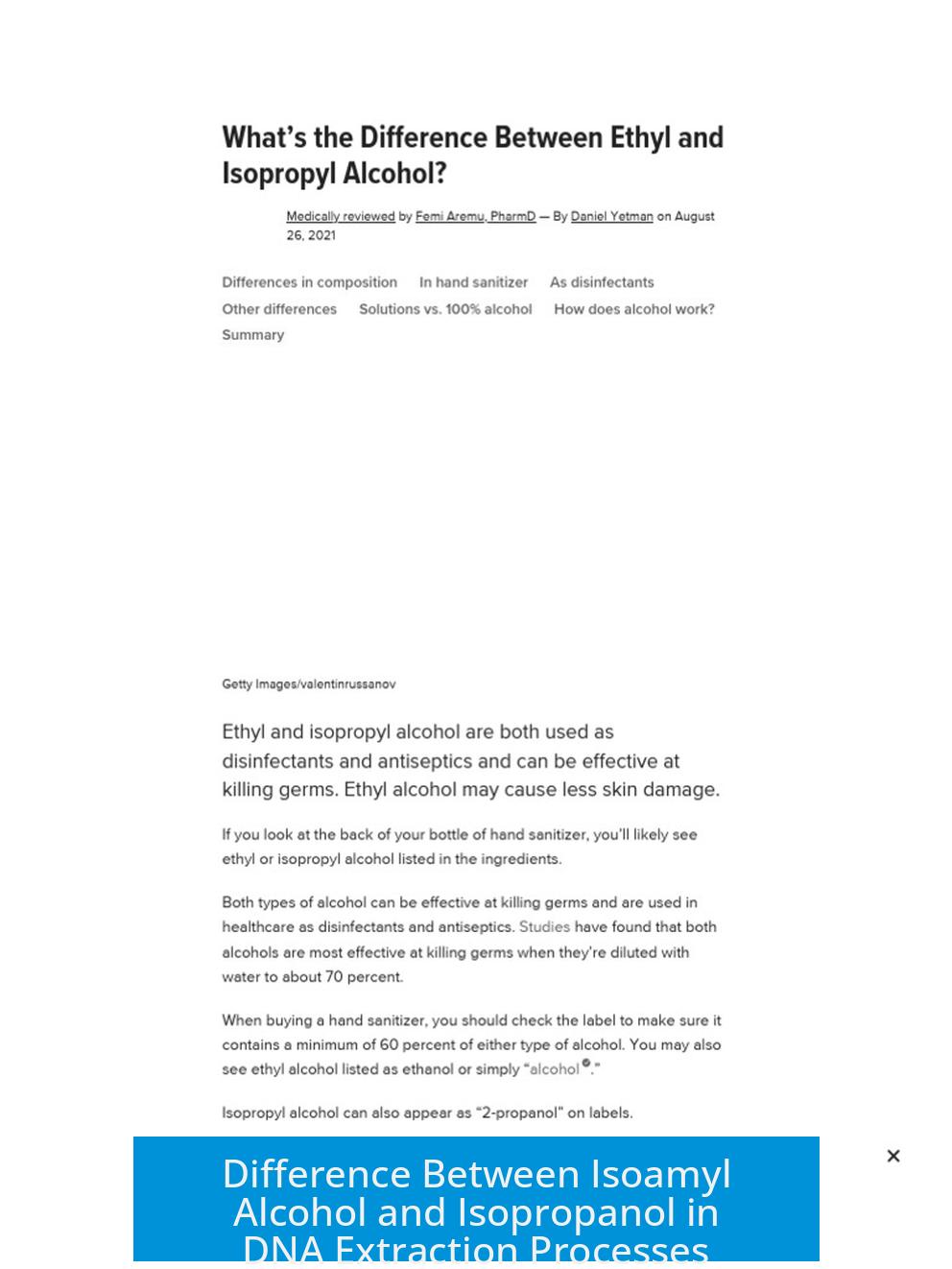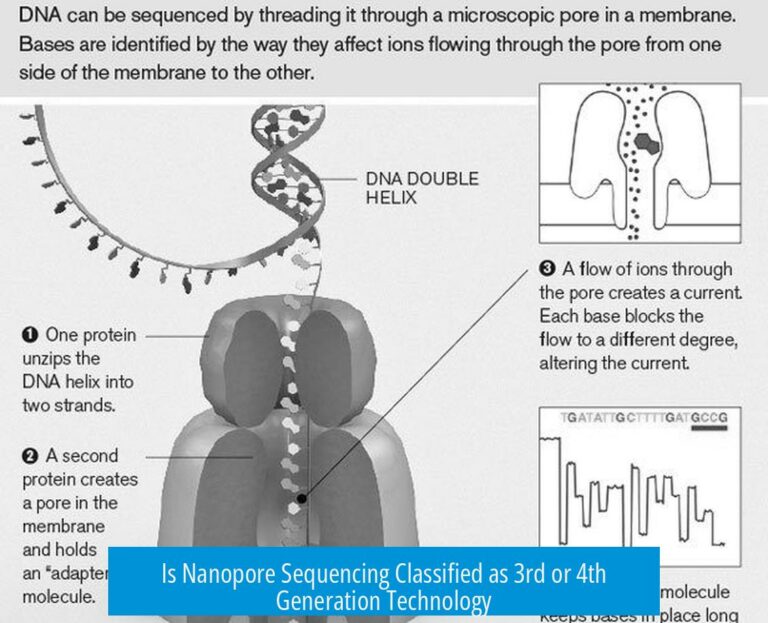Difference Between Isoamyl Alcohol and Isopropanol in DNA Extraction
Isoamyl alcohol and isopropanol serve distinct roles in DNA extraction. Isoamyl alcohol acts as a phase separation enhancer and anti-foaming agent during phenol-chloroform extraction, while isopropanol is primarily used to precipitate DNA from aqueous solutions after extraction.
1. Role of Isoamyl Alcohol in DNA Extraction
Isoamyl alcohol’s main role lies in improving phase separation during the phenol-chloroform method of DNA extraction.
1.1 Phase Separation Enhancer
Traditional protocols added isoamyl alcohol to phenol-chloroform mixtures to create a sharper interface between the organic (phenolic) and aqueous phases. This clearer interphase facilitated easier separation, particularly when using funnels.
Modern protocols rely on high-speed centrifugation, which minimizes the need for isoamyl alcohol to improve phase separation. Nonetheless, older methods highlight its usefulness in clarifying the interface between layers to avoid cross-contamination.
1.2 Anti-Foaming Agent
In phenol:chloroform:isoamyl alcohol (PCI) mixtures, isoamyl alcohol reduces foaming. Foaming can complicate phase removal and handling. This anti-foaming property eases the extraction process but does not influence the DNA precipitation step.
1.3 No Role in DNA Precipitation
Isoamyl alcohol does not precipitate DNA. It is chemically inactive toward nucleic acids in aqueous solutions and simply aids in the extraction step’s mechanical aspects.
2. Role of Isopropanol in DNA Extraction
Isopropanol plays a direct role in precipitating DNA, a critical step following extraction of nucleic acids into the aqueous phase.
2.1 DNA Precipitation Agent
After separating DNA into the aqueous phase, isopropanol is added to reduce DNA solubility and induce precipitation. It achieves this by disrupting hydration shells, allowing DNA molecules to aggregate and form a visible pellet upon centrifugation.
Isopropanol is effective at lower volumes compared to ethanol, typically requiring around 0.6 to 1 volume relative to the aqueous sample, compared to 2 to 3 volumes for ethanol.
2.2 Salt Co-Precipitation
Isopropanol precipitation tends to co-precipitate salts alongside DNA, especially at room temperature. This can introduce impurities into the DNA pellet and affect downstream applications if not properly washed.
2.3 Evaporation Characteristics and Washing
Isopropanol evaporates more slowly than ethanol. Due to this property, DNA pellets are often washed with ethanol after isopropanol precipitation. Ethanol washes reduce salt contamination and aid faster evaporation of residual alcohol, producing a cleaner DNA sample.
2.4 Temperature Dependence
Precipitation with isopropanol is generally done at room temperature to avoid excessive salt precipitation. However, room temperature precipitation may be slower than ethanol precipitation at lower temperatures, though this is not definitively established.
3. Comparative Summary: Isoamyl Alcohol vs Isopropanol
| Aspect | Isoamyl Alcohol | Isopropanol |
|---|---|---|
| Main Use | Enhances phase separation in phenol-chloroform extraction; anti-foaming agent | Precipitates DNA from aqueous phase |
| Role in DNA Precipitation | None | Primary DNA precipitant |
| Typical Volume Required | Minor amounts, part of PCI mixture | ~0.6 to 1 volume of aqueous phase |
| Effect on Salt Contamination | Not applicable | Prone to co-precipitating salts at room temperature |
| Evaporation Characteristics | Not relevant | Slow evaporation; usually followed by ethanol wash |
| Interchangeability | Not interchangeable; unique role | Specific for DNA precipitation; distinct from isoamyl alcohol |
4. Additional Considerations
4.1 Isoamyl Alcohol and Isopropanol Are Not Interchangeable
Despite informal claims, isoamyl alcohol and isopropanol are not standard substitutes for one another in DNA extraction. Their distinct chemical properties dictate unique applications. Isoamyl alcohol does not participate in DNA precipitation, whereas isopropanol is essential for that function.
4.2 Comparison with Ethanol
Isopropanol requires lower volume for precipitation compared to ethanol but results in higher salt co-precipitation and slower evaporation. Ethanol is often preferred during washing steps for better salt removal and rapid drying of DNA pellets.
4.3 Chemical Properties Affecting Use
- Isoamyl alcohol has a higher boiling point and lower miscibility in water than isopropanol, useful for preventing foaming.
- Isopropanol’s intermediate polarity and miscibility make it effective for reducing DNA solubility during precipitation.
5. Practical Protocol Insights
- In phenol-chloroform extraction, PCI mixture (phenol:chloroform:isoamyl alcohol) facilitates separation and minimizes foam.
- Following phase separation, isopropanol addition precipitates DNA, forming a pellet upon centrifugation.
- Post-isopropanol precipitation, washing with ethanol improves purity by removing salts and residual isopropanol.
- DNA pellets require drying to remove residual alcohol; ethanol’s faster evaporation aids this step.
Key Takeaways
- Isoamyl alcohol: Used in phenol-chloroform phases for anti-foaming and clearer separation; does not precipitate DNA.
- Isopropanol: Efficient precipitant of DNA; requires less volume than ethanol; tends to co-precipitate salts.
- Isopropanol precipitation is typically followed by ethanol washes for optimal DNA purity.
- They have distinct roles in DNA extraction and are not interchangeable.
- Choosing the correct alcohol depends on the step within the protocol and desired DNA purity.
What is the main role of isoamyl alcohol in DNA extraction?
Isoamyl alcohol primarily acts as an anti-foaming agent in phenol-chloroform extraction. It improves the clarity of phase separation but does not participate in DNA precipitation.
Can isoamyl alcohol be substituted for isopropanol in DNA precipitation?
Isoamyl alcohol is not commonly used for DNA precipitation. While some suggest interchangeability due to anti-foaming properties, isopropanol remains the standard chemical for precipitating DNA from aqueous phases.
Why is isopropanol preferred over ethanol in DNA precipitation?
Isopropanol requires a smaller volume to effectively precipitate DNA compared to ethanol. However, it precipitates more salts and evaporates slowly, so ethanol is often used to wash the DNA pellet afterward.
Does isoamyl alcohol contribute to salt precipitation during DNA extraction?
No, isoamyl alcohol does not cause salt precipitation. This is a characteristic mainly observed with isopropanol, which tends to co-precipitate salts at room temperature.
How does the evaporation of isopropanol compare to isoamyl alcohol in DNA extraction?
Isopropanol evaporates poorly and usually requires an ethanol wash step to remove residual solvent. Isoamyl alcohol’s evaporation is less relevant because it is used in much smaller amounts and primarily in phase separation steps.





Leave a Comment